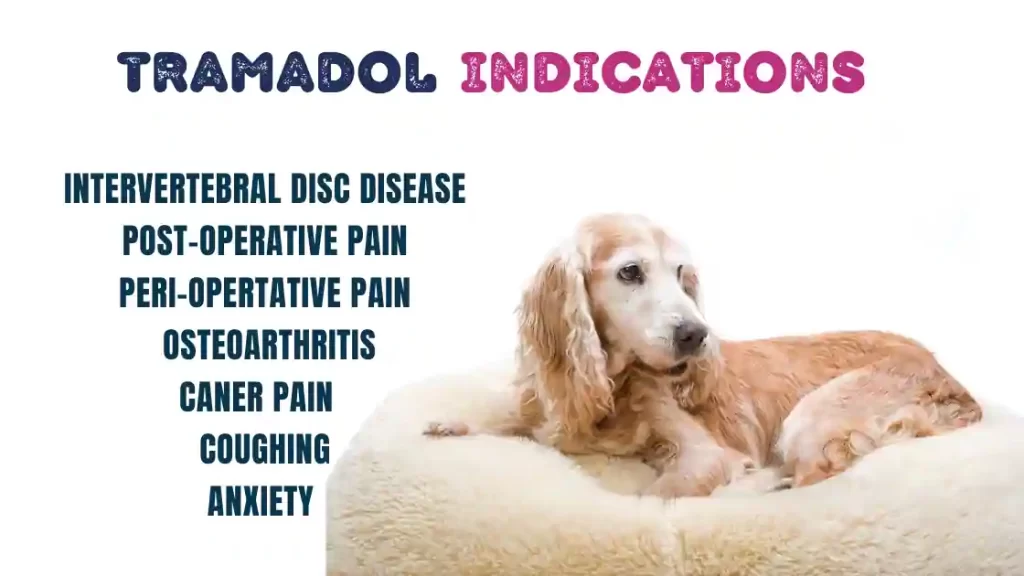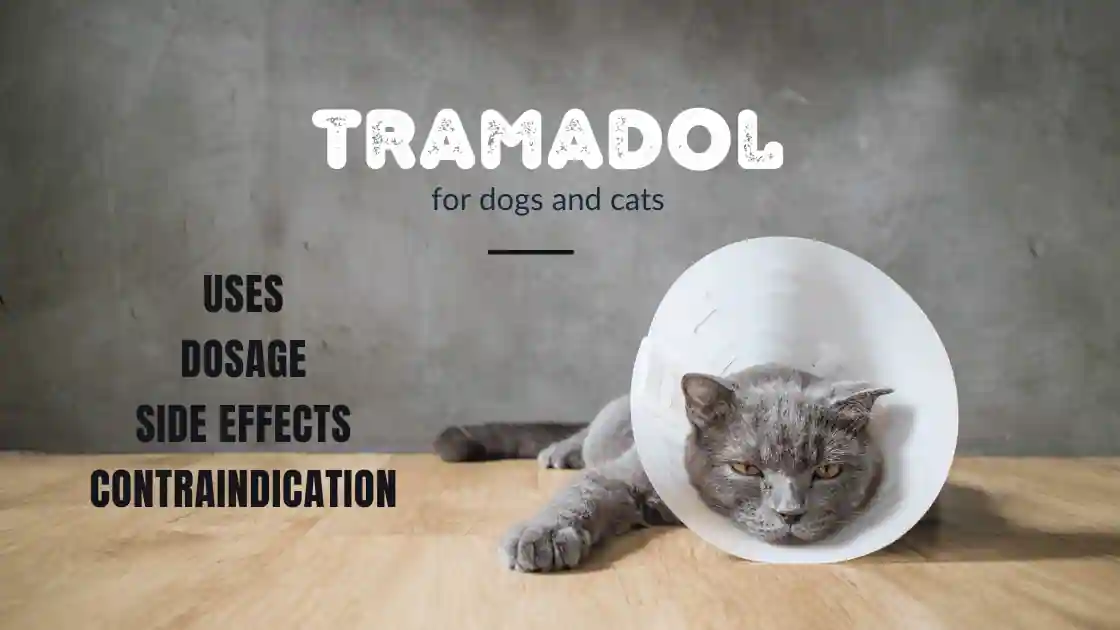Tramadol for Dogs and Cats: Uses, Dosage and Side Effects
What is tramadol?
Tramadol is a prescription medication that is a centrally acting synthetic opioid analgesic commonly used to treat variety of pain in dogs and cats. It has similar effects like morphine but cases less respiratory depression, sedation and gastrointestinal side effects. It is a controlled drug substance and can only be bought with prescription by a registered veterinary practitioner.
How it works?
It works by binding to receptors in the brain and blocking pain signals. Tramadol metabolites (e.g. O-desmethyl tramadol) are weak mu (μ) opioid receptor agonists. It also inhibits the reuptake of neurotransmitters like norepinephrine and serotonin (5-hydroxytryptamine (5-HT)). High norepinephrine levels in the blood also induces the release of serotonin. This results in a pain free euphoric feeling.
Cats have higher bioavailability and superior analgesic profile in comparison to dogs (due to higher concentration of metabolite M1 or O-desmethyl tramadol and longer elimination half-life). That’s why cats require less frequent and lower dose in comparison to dogs.
Tramadol hydrochloride is metabolized in the liver (major proportion 65-70%) and excreted through the kidneys. But it is less bioavailable in animals in comparison to humans.
Doses/ Dosage:
Dogs: 2–5 mg/kg p.o. q8h, 2 mg/kg i.v.
Cats: 2–4 mg/kg p.o. q8h, 1–2 mg/kg i.v., s.c.
(start from 1-2 mg/kg at 12 hours interval)
Most of the time twice daily dosing is adequate but for acute pain management 3-4 times daily dosing may be required.
It is important to follow the dosage instructions provided by your veterinarian, as giving too much tramadol can lead to side effects such as respiratory depression and seizures.
Dosage Forms and Administration:
Tramadol is available in the form of tablet, capsule, and compounded liquid. Preferably it should be given with the food to make acceptability better because it is bitter in taste. Unpalatability of the oral formulations makes is difficult to administer in cats. So better acceptability and palatability it can be masked / disguised in food.
Tablets: 50 mg, 100 mg, 200 mg, 300 mg (also available in sustained release tablets but not effective in dogs with once daily dosing)
Chewable tablets are authorised for use in dogs.
Syrup: 5 mg/ ml, 20 mg/ml
Injections: 50 mg/ml
It’s some human tramadol formulations comes with Paracetamol or acetaminophen which should not be given to cats. Acetaminophen or paracetamol is extremely toxic for cats so always check before giving.
Check if syrup doesn’t contain xylitol as it is toxic for dogs.
Available Veterinary Formulations:
Pet Paltra Oral Solution (20 mg/ml), Tramvetol Tablets (50 mg), UltraFix T Tablets (50 mg), Tralieve Tablets (80 mg)
Tramadol dosage chart for dogs (Kg)
B.wt. Dose (2mg/kg) Tablets (50 mg) Syrup (20mg/ml)
5 10 – 0.5 ml
10 20 – 1.0 ml
15 30 – 1.5 ml
20 40 – 2.0 ml
25 50 1 2.5 ml
30 60 – 3.0 ml
35 70 – 3.5 ml
50 100 2 5.0 ml
Appropriate combination can be used for proper dosing. Measure liquid / syrup carefully.
Don’t give extra dose if you miss a dose and give next dose at scheduled time.
Recommended dosage depends on the body weight of pet, type of pain, duration of therapy and other ongoing medications. Dosage for acute pain will differ from the dosage for chronic pain. Dosage can be increased gradually up to 5 mg/kg if needed.
How much time it takes to effect?
Tramadol is a short acting medicine. It shows a quick effect within 1 to 2 hours. Sometimes in case of chronic pain management it may take up to 2 weeks to reach its full analgesic effect. Analgesic effect lasts upto 12 hours but can be longer in case of liver and kidney ailments.

Uses of Tramadol for Dogs
It can be used to treat mild acute, chronic pain (soft tissue and musculoskeletal) associated with a variety of conditions like:
Osteoarthritis: Joint and musculoskeletal pain associated with it in older dogs.
Cancer: Pain associated with cancer, including pain caused by tumors and pain associated with cancer treatments such as chemotherapy.
Perioperative pain: It is also used to for perioperative pain management.
Post operative pain: To manage post-surgical pain in dogs. It can help reduce pain and inflammation, which can improve the dog’s recovery time.
Dental pain: To manage dental pain and inflammation associated with dental procedures or tooth extraction in dogs.
Other pain: Non surgical intervertebral disc disease (IVDD) or disc herniation in dogs, degenerative myelopathy, lameness,
Other uses: Coughing and anxiety management.
However, before giving tramadol to your dog, it is important to understand its uses, side effects, and dosage.
Side effects of Tramadol:
Tramadol can be an effective pain management tool for dogs, it is important to be aware of the potential side effects. The most common side effects of tramadol for dogs include:
- Sedation – it is most seen side effect in dogs and cats. Drowsiness can be helpful for dogs who are in pain and having difficulty resting, but it can also be problematic if the dog becomes too sedated and is unable to move around or perform daily activities.
- Gastrointestinal signs – hyper salivation, nausea, vomiting, diarrhoea, anorexia or loss of appetite and occasional constipation are common GI signs.
- Respiratory depression – though it is less than morphine but it can depress respiratory function in some dogs, particularly when given in high doses or in combination with other respiratory depressants.
- Other signs like anxiety, tremors, dizziness, dilated pupils, coma, can also be occasionally noticed in case of an overdose.
* Dysphoria (state of feeling uneasy, unhappy or unwell) is more likely to be seen in cats. Incidences of side effects are higher in cats than in dogs.

Interactions with other medications:
It doesn’t treat the underlying cause of pain like NSAIDs so Tramadol can be safely combined with the MSM (methyl sulfonyl methane), galliprant, NSAIDs and gabapentin for effective pain management. Combination of tramadol and gabapentin has minimal side effects and safe for long term use but sudden or abrupt discontinuation may result into withdrawal side effects.
Like trazodone hydrochloride in combination with other serotonin reuptake inhibitors (SRI), monoamine oxidase inhibitors (selegiline), antidepressant (amitriptyline, tricyclic acid) and some other opioids like fentanyl, buprenorphine may result into serotonin syndrome. It may result into serious side effects, seizures and death.
In combination with antihistamines, it can increase sedation. It should not be given with SAMe, benzodiazepines, metoclopramide, quinidine, digoxin, warfarin, erythromycin, cimetidine and cyproheptadine.
Naloxone is an opioid reversal agent but may not be effective in case of tramadol overdose because tramadol is a synthetic opioid not a classic opioid.
Contraindications:
Tramadol is well tolerated in dogs and cats both but use with caution in dogs / cats suffering with epilepsy / seizures and liver or kidney disease. Avoid administration in case of known hyper sensitivity to opioids.
Additionally, do not give to female dogs during pregnancy or nursing period, as it can be passed to the puppies and cause adverse effects. It should be used with caution in older (geriatric) and debilitated animals.
Alternatives to Tramadol:
Sometimes concern arises with pet owner’s abusing opioids intended to their pets or someone in household have access to the drug. Safer alternatives for pain management can be following
Selective COX inhibitors NSAIDs like Firocoxib
Other NSAIDs like Carprofen, Meloxicam
Acupuncture
Herbal formulations like CBD oil and Himpyrin
Anti-inflammatory enzymes like Trypsin, Bromelain, Rutoside etc
Homeopathic remedies (Nux vomica, Arnica, Rhus tox, Causticum etc depending on the symptoms and repertorisation)
Physical therapy (Short wave diathermy, infra-red, Laser therapy etc.)
Supplementation – for arthritic pain management glucosamine, chondroitin,
FAQs:
How much tramadol is safe for a cat?
Starting from 2 mg/kg body weight can be considered safe for cats but dysphoria can be observed.
Is tramadol for cats the same as humans?
No. Some human preparations may contain xylitol or acetaminophen (paracetamol) which is toxic for cats.
Does tramadol make pets sleepy?
Yes. It can help in treating anxiety in pets and can make them feel calm and relaxed.
How long you can give tramadol to your dog or cat?
Depends on the ailment. In case of acute pain may be a few days. In case of chronic pain in arthritis like conditions or anxiety may be upto months.
Can I use gabapentin and tramadol for dogs?
Yes. Both can be combined for the better analgesic effect as a part of multimodal analgesia.
What happens if a human takes tramadol for dogs?
It is not advisable to take formulations meant for dogs or pets. It may contain some preservatives or excipients not suitable for human consumption. In case of accidental consumption consult your doctor or poison control centre immediately.
Can tramadol be used for dogs to treat anxiety?
Yes. Tramadol is indicated for the treatment of anxiety and cough in dogs.
Conclusion:
Tramadol is an effective pain management medicine for dogs, but it is important to use it under the guidance of a veterinarian. It is also important to remember that pain management is not a one-size-fits-all approach and may require dose adjustment or multimodal approach. Overdosage and self-medication can be detrimental but with proper use, tramadol can help improve your dog’s quality of life and manage their pain. Always ensure that the benefits outweigh the potential risks. With proper care and attention, you can help improve your dog’s quality of life and ensure that they are comfortable and happy. It can also be used in cats, rabbits, ferrets and horses safely.
References:
Beatriz, P. Monterio et. al. (2017). Analgesic efficacy of tramadol in cats with naturally occurring osteoarthritis. PLoS One. 12(4): e0175565.
KuKanich, B. and Papich, M.G. (2004). Pharmacokinetics of tramadol and the metabolite O-desmethyltramadol in dogs. J Vet Pharmacol Ther. 27:239-246.
Disclaimer: This post has been written after reviewing available literature and utmost care has been taken. It is intended for vets and evaluation of pet’s condition is necessary before starting tramadol. Self-medication of your pet without consulting your veterinarian can be life threatening for your pet.



![Read more about the article Bachelor of Veterinary Science [BVSc] Bachelor of Veterinary Science and Animal Husbandry [BVSc & AH]](https://theveterinarymedicine.com/wp-content/uploads/2021/10/Bachelor-of-Veterinary-Science-and-Animal-Husbandry-BVSc-AH-A-Detailed-Course-Overview-300x169.jpeg)


Pingback: Serotonin Syndrome in Dogs – The Veterinary Medicine